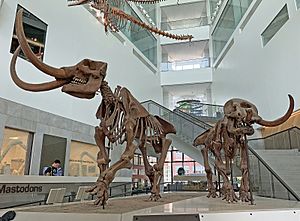Mastodon facts for kids
Quick facts for kids Mastodon |
|
|---|---|
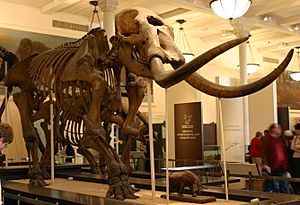 |
|
| Mounted M. americanum skeleton (the "Warren mastodon"), AMNH | |
| Scientific classification |
|
| Unrecognized taxon (fix): | Mammutoidea |
| Family: | †Mammutidae |
| Genus: | †Mammut Blumenbach, 1799 |
| Type species | |
| †Elephas americanum Kerr, 1792
|
|
| Species | |
| Synonyms | |
A mastodon was a huge, extinct animal. It looked a lot like an elephant or a mammoth. The name "mastodon" means "breast tooth." This is because of the shape of their teeth.
Mastodons lived in North and Central America. They lived from the late Miocene period until the end of the Pleistocene. They died out about 10,000 to 11,000 years ago. Mastodons are related to elephants. Their family split off from elephant ancestors over 25 million years ago.
The American mastodon (M. americanum) and the Pacific mastodon (M. pacificus) are the most famous types. They lived in herds, mostly in forests. American mastodons ate woody plants. This was different from mammoths, who lived at the same time. Mastodons died out during a big extinction event. This event killed many large animals in the Americas. Scientists think it was caused by climate change and hunting by early humans.
Contents
Discovering Mastodons
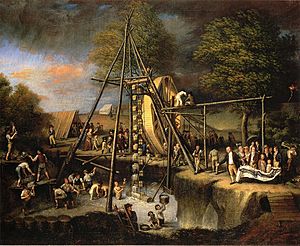
The first mastodon tooth was found in 1705. A farmer in New York found it. It weighed about 2.2 kilograms (4.8 pounds). People called this mystery animal the "incognitum."
In 1739, French soldiers found more bones in Kentucky. They sent these bones to a museum in Paris. Later, similar teeth were found in South Carolina. Some enslaved African people there said the teeth looked like those of African elephants.
More bones and tusks were found in Ohio. People started calling the "incognitum" a "mammoth." This was because mammoths were being dug up in Siberia. In 1796, a French scientist named Georges Cuvier had a new idea. He said mammoths were not just elephants. He believed they were a species that no longer existed.
In 1799, Johann Friedrich Blumenbach gave the American remains the name Mammut. He thought they were mammoths. But other scientists noticed differences. Mastodon teeth had large, cone-shaped bumps. Mammoth and elephant teeth had flat plates. This showed they were different animals. In 1817, Cuvier named the "incognitum" Mastodon. This name means "breast tooth" in Ancient Greek.
How Mastodons Looked
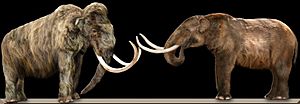
Mastodons were shorter than mammoths and modern elephants. But they had longer and wider bodies. Their legs were shorter and very muscular. Their leg bones were also much thicker. This made mastodons look very strong. Female mastodons were smaller than males, like modern elephants.
Male American mastodons were about 2.9 meters (9.5 feet) tall at the shoulder. They weighed around 8 metric tons (8.8 short tons). Some large males could be 3.25 meters (10.7 feet) tall. They could weigh up to 11 metric tons (12 short tons). This made them much heavier than modern elephants of the same height.
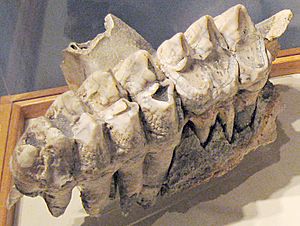
Mastodons had a long, low skull. They had long, curved tusks. Male tusks were bigger and more curved. Their teeth were shaped like cones or cusps. These teeth were perfect for chewing leaves and branches. Mammoth and elephant teeth are flat.
Mastodons are often shown with thick, woolly hair. This is like a woolly mammoth. However, there is no real proof they had such thick hair. Their long tails suggest they lived in warmer places. Their size and weight also make it unlikely they were very hairy.
Mastodon Social Life
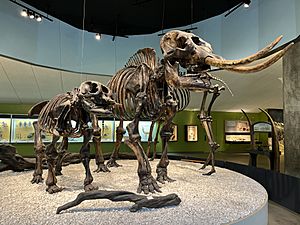
Scientists study mastodon bones and tusks. They think mastodons lived in groups. These groups were like modern elephants. They included adult females and their young. These groups are called mixed herds.
Male mastodons left the mixed herds when they grew up. They lived alone or in groups with other males. Like elephants, mastodons probably mated all year round. Males and females would find each other when they were ready to mate.
What Mastodons Ate
Mastodons mostly ate plants by browsing. This means they ate leaves and branches from trees and bushes. They did not graze on grass like some other large animals. They preferred certain types of plants. This might have stopped them from moving into South America. They would have had to cross large grasslands to get there.
Many studies of mastodon stomach contents show they ate conifer twigs. But some mastodons, like the Burning Tree mastodon, ate different things. They ate low, soft plants. This suggests they sometimes ate both woody plants and grass. Studies of their teeth also show this. Mastodons could change their diet based on where they lived. They adapted to different forests or swamps.
Where Mastodons Lived
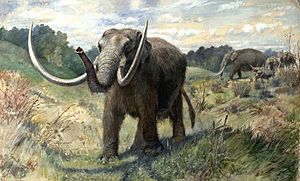
We don't know much about where most mastodon species lived. This is because we have found few fossils. But the American mastodon (M. americanum) is different. It is one of the most widespread large animals from the Pleistocene in North America.
Fossils of M. americanum have been found all over. They range from Alaska in the north to Florida in the east. They have also been found as far south as Mexico and even Honduras. This shows how far they spread during the Late Pleistocene. Many fossils are found in the Mid-Atlantic region of the US.
Mastodons loved forests and woodlands. They ate trees and shrubs. They did not seem to move south into South America. This might be because they specialized in eating certain plants.
In 2022, scientists found mastodon DNA in Greenland. This DNA was from 2 million years ago. It suggests mastodons lived as far north as Greenland. At that time, northern Greenland was much warmer. It had a boreal forest with many different animals. These are some of the oldest DNA pieces ever found.
Why Mastodons Disappeared
Fossils show that mastodons likely died out in North America about 10,500 years ago. This was part of a big extinction event. Many large animals from the Pleistocene disappeared. Many scientists believe human hunting caused this.
Early humans, called Paleo-Indians, came to the Americas about 13,000 years ago. Their hunting might have slowly reduced the mastodon population. Studies of mastodon tusks from the Great Lakes region show something interesting. Before they died out, mastodons matured at a younger age. This is not what you would expect if the environment was bad. But it makes sense if there were fewer mastodons. This would happen if humans were hunting them.
However, other studies suggest climate change played a big role. DNA from ancient plants and animals shows this. It suggests that major changes in plants happened at the same time as animals disappeared. So, climate change was very important. But human hunting might have made it harder for mastodons to survive.
See also
 In Spanish: Mastodonte para niños
In Spanish: Mastodonte para niños
Images for kids
-
Excavation of a mastodon in a golf course in Heath, Ohio, 1989.


